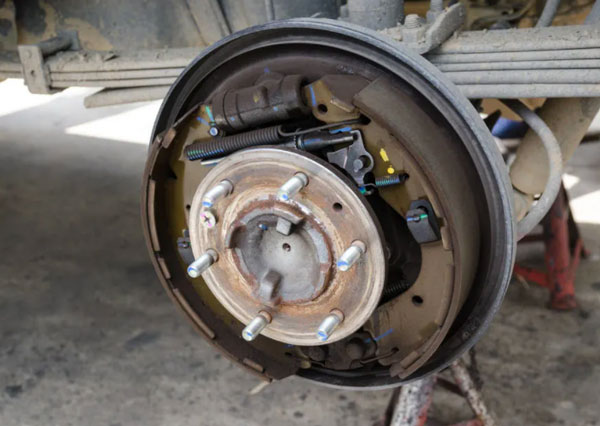How does the drum brake work?
Automobile drum brake system includes drum, brake shoe and wheel cylinder.The cylinder pushes the shoes into the roller to slow or stop your car.
Some vehicles use a braking system that consists partly of drum brakes.They are so called because they use friction, which acts as a metal drum attached to the wheel to slow and stop the car.Although disc brakes provide better braking performance and have become more common in modern cars, drum brakes are still used in some applications.Drum brakes are sometimes found on the rear wheels of entry-level cars as well as in conventional cars.

Components of a drum brake system
Backing plate: Provides a solid foundation for other components in drum brakes.Attached to the shaft sleeve.
Brake drum: Bolts are fixed to the hub and rotate with the wheel.It is usually made of cast iron and is resistant to high temperature and wear.This is what you see when you assemble a drum brake, which is the component that applies the braking force to slow or stop the car.
Wheel cylinder: Consists of two pistons, each at each end of the cylinder, used to operate the brake shoes.The cylinder exerts pressure on the pistons, which pushes the brake shoes against the drum, causing the car to slow or stop.You need one cylinder per wheel.
Brake shoe: Push into the brake drum to create the friction needed to slow or stop the car.Fixed to the backing but able to slide when pressure is applied from the wheel cylinder.A lining consisting of organic or metallic compounds is attached.The lining is actually something that comes into contact with the roller and wears away with use.Each brake contains two shoes.The main brake shoe is closer to the front of the vehicle, while the auxiliary brake shoe is closer to the rear.Brake shoes may be interchangeable depending on the type and brand.
Automatic regulator: the distance between the brake shoes and the drum should be kept constant even if the bushing is worn.
Reset spring: When the driver releases the brake pedal, pull the brake shoe back from the drum.
Function of drum brake
The brake should respond immediately.When the driver presses the pedal, a piston inside the brake master pump pressurizes the hydraulic fluid in the brake line, pressurizes the brake wheel cylinder and pushes the boot into the drum.The stronger the driver presses on the pedal, the greater the pressure inside the brake line and the greater the pressure of the shoe on the drum.The shoe moves very little, and once the driver releases the pedal, the reset spring should pull it back from the drum.
Emergency drum brake
Some vehicles have disc brakes on all four wheels, but still use small drum brakes in the hub assembly as emergency (or stop) brakes.When applying an emergency brake, a lever attached to a cable pulls the boot apart.This provides direct control, rather than through the wheel cylinder or brake hydraulic system, allowing the vehicle to stop even if conventional braking fails.
Wear of drum brakes
Drum and brake shoes should be the only components in a drum brake system that need to be replaced.Shoe linings wear out with use, and new shoes typically need to be installed every 35,000 miles, although this depends on your particular vehicle and driving habits.Brake drums can have a service life of over 100,000 miles, but usually need to be replaced in pairs.Otherwise, the wheel cylinder, automatic regulator and resetting spring should enable the vehicle to last long, although mechanical failure or damage due to debris or crash may still occur.However, it is best to check brake fluid every 24,000 to 36,000 miles, and if a leak is suspected, check immediately.
Symptoms of a drum brake problem
There are several symptoms that can make drivers aware of their drum brake problems.
Brake noise: Excessive or abnormal noise may indicate low or lost lining as the lining wears away with use.A technician can check why your brakes are noisy, but changing the brake shoes will usually solve the problem.
Pedal vibration: If the brake pedal vibrates or vibrates when pressed, the drum may be distorted.The brake drum is supposed to be perfectly round and can warp if overused or overheated.Usually, replacing the drum will solve the problem and restore normal braking.
Brake pedal low or low: the brake pedal should have a good feel, braking force should be the same as the amount of pressure applied on the pedal.If the pedal feels soft or lower than usual, it is usually a sign of brake fluid contamination or system leakage.Air or water in a fluid can reduce its effectiveness, and leakage is a serious problem.Have the mechanic flush the fluid or check the system for leaks to restore full braking power.A failure wheel cylinder can also be a culprit for spongy or low-speed brake pedals.
Brakes are arguably the most important safety system in a car, so be on the lookout for any unusual symptoms that might indicate a need to replace a drum brake part.
We will do a good job in every content,do our best to solve the problem for each customer,Thank you for your reading.




Leave A Comment